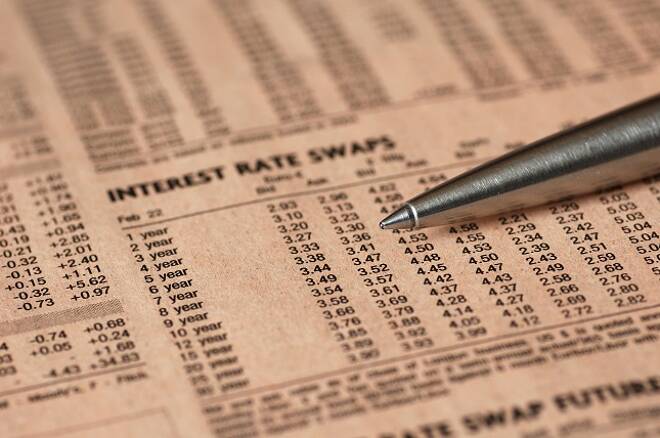Advertisement
Advertisement
U.S Mortgage Rates Surge to 4-Year Highs
By:
Procrastination comes at a price and ‘want-to-be’ homeowners who delayed the application and purchasing of a home will have paid a heavy price, with mortgage rates rising for a 3rd consecutive week to levels not seen in over 4-years.
A jump in 10-year U.S Treasury yields to 3% off the back of a continued build-up of inflationary pressure from rising commodity prices and increasing expectations of a 4th rate hike for the year, saw 30-year fixed-rate mortgages jump 11 basis points to 4.58%, the highest level since August 2013
Economic data through the week eased concerns over the U.S economy entering an extended soft path, with both service and manufacturing sector activity picking up at the start of the 2nd quarter, the weekly jobless claims hitting levels not seen since the late 1960s and the U.S trade balance seeing a sizeable narrowing in March. With consumer confidence coming in ahead of expectations and recovering from a fall in March, the outlook for consumer spending also looks positive and favoring the outlook for the economy and inflation.
The continued rise in commodity prices, which has seen the Bloomberg Commodity Index gain 2.33% for the current month and the rise in crude oil prices, WTI up 12.5% year-to-date, has added to the upbeat sentiment towards inflation that has seen the markets increasingly price in a 4th rate hike for the year.
In spite of the continued upward trend in mortgage rates, demand for mortgages has certainly not eased, with an ever-tightening labour market and pickup in the pace of wage growth driving new home sales at the end of the 1st quarter, new up sales up 4% in March, off the back of a 3.6% rise in February.
While a shortage of inventory continues to be an issue, existing home sales were also on the rise in March, up 1.1%, following a 3% rise in February, home buyers undeterred by 30-year fixed mortgage rates having risen by an average 55 basis points over the last year, current levels still considered attractive when compared with historical rates.
The rise in sales will continue to add upward pressure on house prices that, when combined with the upward trend on mortgage rates, will weigh on the pockets of prospective home buyers and influence the decision making process.
Freddie Mac rates for new mortgages last week were quoted to be:
- 30-year fixed rate loan jumped from 4.47% to 4.58% last week, while up from 4.03% a year ago.
- 15-year fixed rates rose from 3.94% to 4.02% last week, while up from 3.27% from a year ago.
- 5-year fixed rates increased from 3.67% to 3.74% over the week, while up from last year’s 3.12%.
Mortgage Bankers’ Association Rates for last week were quoted to be:
- Average interest rates for 30-year fixed, backed by the FHA increased from 4.70% to 4.71%, continuing to move back towards the 7-year high hit last month.
- The average interest rate for 30-year fixed with conforming loan balances rose from 4.66% to $4.73%, hitting the highest level since Sept-13.
- Average 30-year rates for jumbo loan balances jumped from 4.53% to 4.64%, hitting the highest level since Jan-14.
Weekly figures released by the Mortgage Bankers Association showed that the Market Composite Index, which is a measure of mortgage loan application volume, fell by 0.2%, following the previous week’s 4.9% rise week-on-week. The marginal decline considered negligible when factoring in the upward trend in mortgage rates, supporting the positive March existing and new home sales figures released last week.
The Refinance Index also fell, down 0.3%, following the previous week’s 4% rise, with the refinance share of mortgage activity falling further to 37.2% of total applications, the lowest level since Sep-08 and down from the previous week’s 37.6%, the downward trend continuing.
The dilemma for prospective home buyers continues to become ever more challenging, with last week’s surge a warning of how quickly rates can move as sentiment towards inflation shifts, the lack of inflationary pressure having pinned back mortgage rates in recent years.
Recent economic data has eased concerns over the U.S economy and, with the talk of a trade war easing, it could be full steam ahead for the U.S economy in the 2nd quarter. Friday’s GDP numbers out of the U.S were better than expected and, with the U.S economy tending to fare better as the year progresses, 2.3% growth is certainly not a bad baseline going into the 2nd quarter, all of which continues to support the upward trend in borrowing costs. It’s not just mortgages that are getting hit, but also other borrowing costs, making it advisable to pay down loans and credit cards sooner rather than later in order to minimize the impact of rising borrowing costs on disposable incomes.
For the week ahead, it’s another hectic economic calendar, with inflation, personal spending and private sector PMI numbers scheduled for release ahead of the all-important nonfarm payroll and wage growth figures on Friday. The FED will also be making its May monetary policy decision on Wednesday and, while few are expecting rates to be raised, the FOMC statement will likely have an influence, positive economic data and a likely rise in inflation supporting a more hawkish statement.
All things considered, mortgage rates could well be on the rise again in the coming week, though the Oval Office is more than capable of overshadowing the FED and economic data should the need arise.
About the Author
Bob Masonauthor
With over 28 years of experience in the financial industry, Bob has worked with various global rating agencies and multinational banks. Currently he is covering currencies, commodities, alternative asset classes and global equities, focusing mostly on European and Asian markets.
Advertisement
